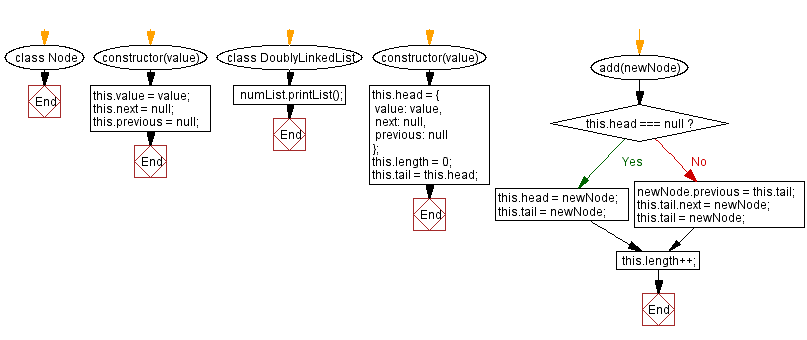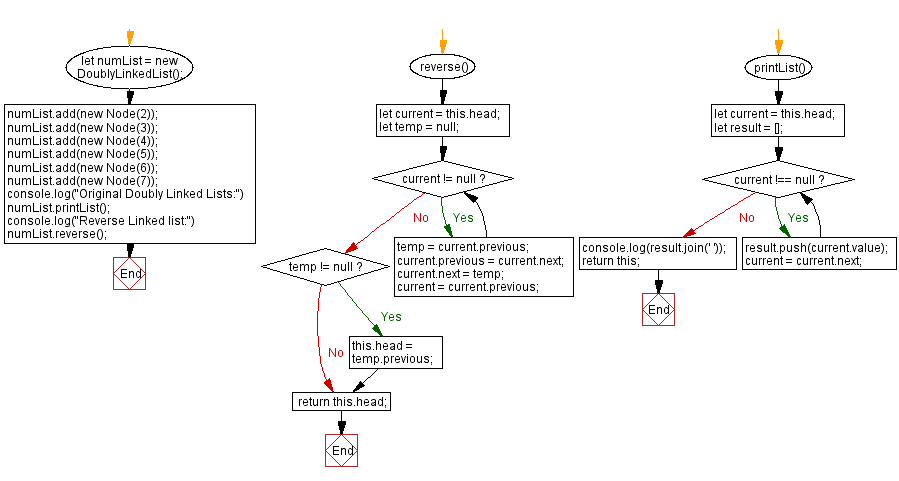JavaScript Exercises: Print a Doubly Linked lists in reverse order
JavaScript Data Structures: Exercise-9 with Solution
Create a DLL of n nodes and display in reverse
Write a JavaScript program to create a Doubly Linked lists of n nodes and display it in reverse order.
Sample Solution:
JavaScript Code:
// Define a class for creating nodes of a doubly linked list
class Node {
constructor(value) {
this.value = value; // Store the value of the node
this.next = null; // Pointer to the next node in the list, initially set to null
this.previous = null; // Pointer to the previous node in the list, initially set to null
}
}
// Define a class for creating a doubly linked list
class DoublyLinkedList {
constructor(value) {
// Initialize the head node with the given value and no next or previous node
this.head = {
value: value, // Store the value of the head node
next: null, // Pointer to the next node in the list, initially set to null
previous: null // Pointer to the previous node in the list, initially set to null
};
this.length = 0; // Initialize the length of the list to 0
this.tail = this.head; // Set the tail node to the head node initially
}
// Method to add a new node at the end of the list
add(newNode) {
// Check if the head is null, indicating an empty list
if (this.head === null) {
this.head = newNode; // Set the head to the new node
this.tail = newNode; // Set the tail to the new node
} else {
newNode.previous = this.tail; // Set the previous pointer of the new node to the current tail
this.tail.next = newNode; // Set the next pointer of the current tail to the new node
this.tail = newNode; // Update the tail to the new node
}
this.length++; // Increment the length of the list
}
// Method to reverse the doubly linked list
reverse() {
let current = this.head; // Start from the head of the list
let temp = null; // Temporary variable to store the previous node during reversal
while (current != null) {
temp = current.previous; // Store the previous node
current.previous = current.next; // Swap the previous and next pointers of the current node
current.next = temp;
current = current.previous; // Move to the next node
}
if (temp != null) {
this.head = temp.previous; // Update the head pointer to the last node after reversal
}
return this.head; // Return the head of the reversed list
}
// Method to print the values of the nodes in the list
printList() {
let current = this.head; // Start from the head of the list
let result = []; // Array to store the values of the nodes
while (current !== null) {
result.push(current.value); // Push the value of the current node to the array
current = current.next; // Move to the next node
}
console.log(result.join(' ')); // Log the values of the nodes separated by space
return this; // Return the DoublyLinkedList object for chaining
}
}
// Create a new instance of the DoublyLinkedList class
let numList = new DoublyLinkedList();
// Add nodes to the list
numList.add(new Node(2));
numList.add(new Node(3));
numList.add(new Node(4));
numList.add(new Node(5));
numList.add(new Node(6));
numList.add(new Node(7));
// Display the original doubly linked list
console.log("Original Doubly Linked List:");
numList.printList();
// Reverse the linked list and display it
console.log("Reverse Linked List:");
numList.reverse();
numList.printList();
Output:
Original Doubly Linked Lists: 2 3 4 5 6 7 Reverse Linked list: 7 6 5 4 3 2
Flowchart:


Live Demo:
See the Pen javascript-doubly-linked-list-exercise-9 by w3resource (@w3resource) on CodePen.
For more Practice: Solve these Related Problems:
- Write a JavaScript function that constructs a doubly linked list with n nodes and then prints the list in reverse order using the tail pointer.
- Write a JavaScript function that traverses a DLL backwards from the tail to the head and displays each node’s data.
- Write a JavaScript function that verifies reverse traversal by comparing the output with an array of node values reversed.
- Write a JavaScript function that creates a DLL from an array and displays its elements in reverse order using a while loop.
Go to:
PREV : Get the value of a node at a given position in a DLL.
NEXT : Convert a DLL into an array.
Improve this sample solution and post your code through Disqus
What is the difficulty level of this exercise?
Test your Programming skills with w3resource's quiz.
